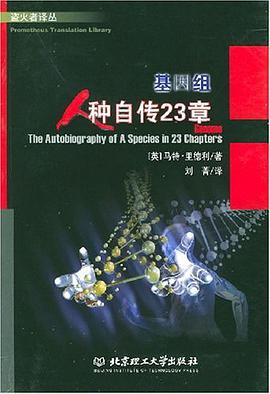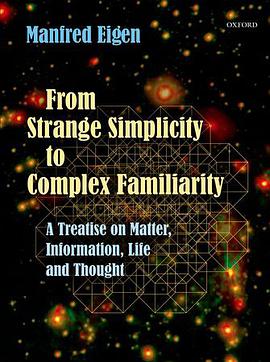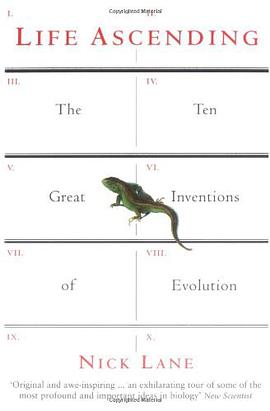生物
基因组 豆瓣
Genome: The autobiography of a species in 23 chapters
作者:
马特·里德利
译者:
刘菁
北京理工大学出版社
2003
- 10
也许可以说,组成人类基因组的23对染色体的图谱绘制是新世纪最重大的科学发现,它提出的问题与它解答了的问题同样多。这些问题将深刻地影响我们对疾病、寿命和自由意志的思考方式。这些问题将影响你的后半生。这个让人难以置信的突破会有什么后果?《基因组:人类自传》在这方面提供了超群的洞察力。通过在每一对染色体上选择一个新近发现的基因并讲述其故事,马特·里德利叙述了我们这个物种及祖先从生命出现之初到未来医学边缘的历程。他探讨了由于基因组的图谱绘制而出现的科学、哲学等问题,这将帮助你理解这个科学里程碑对你、对你的孩子、对人类意味着什么。
动物有意识吗? 豆瓣
作者:
阿尔茨特
译者:
马怀琪
2004
- 5
《动物有意识吗》主要内容:如果儿子撒谎,如果猫儿有思想,如果大象痛苦忧伤。动物能够思考吗?它们有情感吗?它们对自己是否有所了解?也就是说,它们有没有某程度的自我意识?许多科学家为此争论不休。福尔克·阿尔茨特和伊曼努尔·比尔梅林对这些问题进行了深入研究。他们讲述了许多简直令人骓以置信的动物行为,并根据来自生物学、动物学以及行为研究的最新认识对其进行了审视。最新的研究成果同样证实了两位作者多年以来的实践经验;动物在许多方面的行为,如果不从情感和思维能力的角度考虑,是无法做出合理解释的。
根据这一认识得出的紧迫结论就是:我们必须彻底反思我们对待动物的态度并建立一种人与动物的崭新关系。
根据这一认识得出的紧迫结论就是:我们必须彻底反思我们对待动物的态度并建立一种人与动物的崭新关系。
From Strange Simplicity to Complex Familiarity 豆瓣
作者:
Manfred Eigen
Oxford University Press
2013
- 3
- Presents the life's work of a Nobel Laureate and internationally recognised leader in the field
- Builds new bridges between physics and biology
- Provides a physical basis for Darwin's principle of natural selection
- Presents a new theory of information including semantics
This book presents a vivid argument for the almost lost idea of a unity of all natural sciences. It starts with the "strange" physics of matter, including particle physics, atomic physics and quantum mechanics, cosmology, relativity and their consequences (Chapter I), and it continues by describing the properties of material systems that are best understood by statistical and phase-space concepts (Chapter II). These lead to entropy and to the classical picture of quantitative information, initially devoid of value and meaning (Chapter III). Finally, "information space" and dynamics within it are introduced as a basis for semantics (Chapter IV), leading to an exploration of life and thought as new problems in physics (Chapter V).
Dynamic equations - again of a strange (but very general) nature - bring about the complex familiarity of the world we live in. Surprising new results in the life sciences open our eyes to the richness of physical thought, and they show us what can and what cannot be explained by a Darwinian approach. The abstract physical approach is applicable to the origins of life, of meaningful information and even of our universe.
- Builds new bridges between physics and biology
- Provides a physical basis for Darwin's principle of natural selection
- Presents a new theory of information including semantics
This book presents a vivid argument for the almost lost idea of a unity of all natural sciences. It starts with the "strange" physics of matter, including particle physics, atomic physics and quantum mechanics, cosmology, relativity and their consequences (Chapter I), and it continues by describing the properties of material systems that are best understood by statistical and phase-space concepts (Chapter II). These lead to entropy and to the classical picture of quantitative information, initially devoid of value and meaning (Chapter III). Finally, "information space" and dynamics within it are introduced as a basis for semantics (Chapter IV), leading to an exploration of life and thought as new problems in physics (Chapter V).
Dynamic equations - again of a strange (but very general) nature - bring about the complex familiarity of the world we live in. Surprising new results in the life sciences open our eyes to the richness of physical thought, and they show us what can and what cannot be explained by a Darwinian approach. The abstract physical approach is applicable to the origins of life, of meaningful information and even of our universe.
Life Ascending 豆瓣
作者:
Nick Lane
Profile Books
2010
- 1
How did life invent itself? Where did DNA come from? How did consciousness develop? Powerful new research methods are providing vivid insights into the makeup of life. Comparing gene sequences, examining atomic structures of proteins, and looking into the geochemistry of rocks have helped explain evolution in more detail than ever before. Nick Lane expertly reconstructs the history of life by describing the ten greatest inventions of evolution (including DNA, photosynthesis, sex, and sight), based on their historical impact, role in organisms today, and relevance to current controversies. Who would have guessed that eyes started off as light-sensitive spots used to calibrate photosynthesis in algae? Or that DNA’s building blocks form spontaneously in hydrothermal vents? Lane gives a gripping, lucid account of nature’s ingenuity, and the result is a work of essential reading for anyone who has ever pondered or questioned the science underlying evolution’s greatest gifts to man.




